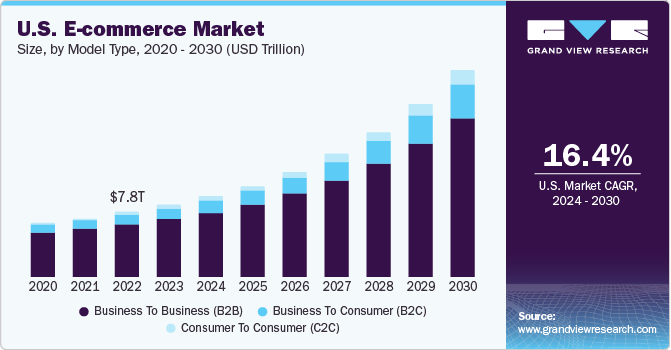The global e-commerce market size is anticipated to reach USD 83.26 trillion by 2030, exhibiting a CAGR of 18.9% from 2024 to 2030, according to a new study by Grand View Research Inc. The market has grown substantially as a result of the increasing popularity of omnichannel retailing, in which companies combine their offline and online platforms. Customers nowadays anticipate a consistent online, mobile, and in-store shopping experience across all channels. Online retailers like Amazon, Alibaba, and eBay have contributed significantly to the growth of the e-commerce industry.
These marketplaces link consumers with a wide variety of independent vendors who provide a wide selection of goods. Customers find it convenient to locate several brands and items in one location, and sellers gain from being exposed to a wide range of potential customers. Customers can use Buy Now, Pay Later services to make purchases and pay for them via monthly installments. In addition to typical subscription boxes, e-commerce companies are broadening their subscription offerings including services such as membership-based usage of exclusive information, early product releases, and customized recommendations.
Live commerce platforms, such as Alibaba's Taobao Live, have grown in popularity, and this trend is projected to continue as a dynamic approach to communicating with customers. Walmart's e-commerce platform now features shoppable live streams, allowing brands to promote products in real time. Utilizing smartphones or AR glasses, consumers can experience products in real-world surroundings. The widespread expansion of the e-commerce market is anticipated to be aided by business model development and technological advancement in the forecasted period.
Gather more insights about the market drivers, restrains and growth of the Global E-commerce Market
Due to the worldwide reach of e-commerce marketplaces, businesses can reach customers from any part of the world, and customers can now access a wide range of products from across the globe. Innovations in payment processing, international shipping, and logistics have made cross-border trading more accessible. E-commerce companies are better equipped to adjust to shifting consumer demands and market dynamics if they foster a culture of ongoing innovation and experimentation. New business strategies that attract a wide spectrum of customers, such as direct-to-consumer (DTC) brands, subscription services, and flash sales, keep the industry competitive.
Businesses that sell online and operate internationally will prioritize cultural awareness significantly in the forecasted period. Gaining an understanding of regional tastes, traditions, and customer behavior is crucial for effective market penetration. Hyperlocal models may be adopted by e-commerce platforms or marketplaces more frequently, enabling transactions inside geographic locations. This trend helps small businesses in the area and is in line with the desire for quicker deliveries. E-commerce companies aim to investigate and establish alliances with regional suppliers and service providers to provide a wide variety of goods and services at the region or local level in the anticipated period.
E-commerce Market Report Highlights
- The home appliances segment is expected to register the highest CAGR of around 21% over the forecast period.E-commerce platforms constantly introduce new and creative home and kitchen products to fulfill evolving customer demands and preferences. Online evaluations and suggestions have a significant impact on consumer decision-making. Positive feedback can have significant effects on e-commerce sales of home and kitchen products which is prompting the expansion and development of e-commerce market.
- The B2C segment is expected to register the highest CAGR of around 19% over the forecast period. The expansion of subscription-based models in B2C e-commerce, which provide easy and frequent product access, is expected to be a key driver of future market growth. Changing consumer behavior, driven by elements such as social networking sites, online reviews, and environmental awareness, changes the dynamics of B2C e-commerce.
- The MEA region is expected to register the highest CAGR of around 22.8% over the forecast period. Mobile phone dominance in various MEA countries makes m-commerce (mobile commerce) a significant driver, with easy online shopping through smartphones. Moreover, various governments in the MEA region are actively promoting e-commerce through initiatives, such as, implifying regulations for online businesses, investing in digital infrastructure development, and encouraging internet access and digital literacy.
List of Key Players in the E-commerce Market
- com, Inc.
- com
- ASOS
- Costco Wholesale Corporation
- Dangdang
- eBay Inc.
- com
- com
- Lazada
- MercadoLibre S.R.L.
- Shopify
- Shopee
- Walmart
- Wayfair LLC
- Zalando
Order a free sample PDF of the E-commerce Market Intelligence Study, published by Grand View Research.



